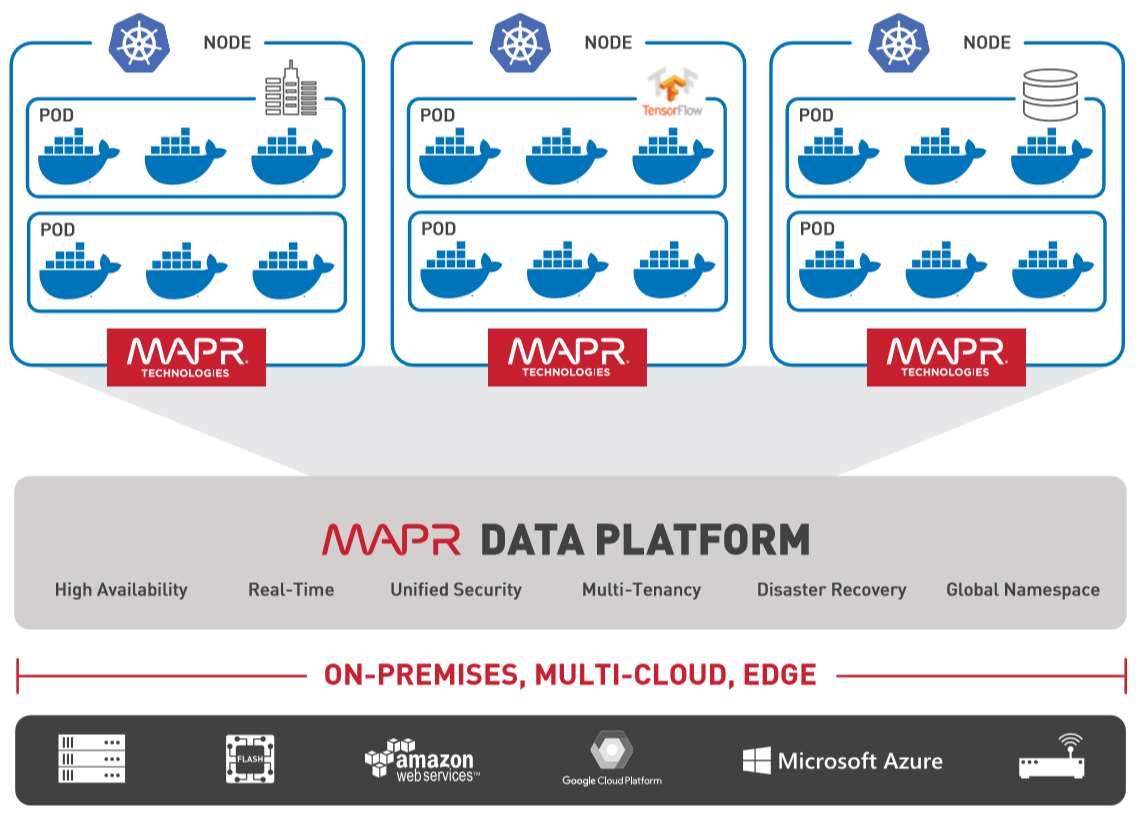MapR Data Fabric for Kubernetes FlexVolume Driver Overview
Describes how the FlexVolume driver for MapR Data Fabric for Kubernetes integrates with Kubernetes to provide persistent data for containers.
To review the FlexVolume Driver end-of-life announcement, see support advisory 4822. For a comparison of the CSI and FlexVolume technologies, see FlexVolume.
About the MapR Data Fabric for Kubernetes
- Provides long-lived, persistent storage for Pods and their containers.
- Allows containers running in Kubernetes to use the MapR filesystem for all of their storage needs.
- Allows secure storage of all container states in MapR XD Distributed File and Object Store.

The MapR Data Fabric for Kubernetes consists of a set of Docker
containers and their respective .yaml
configuration files for installation into
Kubernetes. Once installed, both a Kubernetes FlexVolume Driver for MaprFS and a Kubernetes Dynamic Volume Provisioner are available for both static and
dynamic provisioning of MapR
storage.
Containers
Containers are stand-alone, executable images of applications. They freeze all code needed to run an application, including an OS. Unlike VMs, containers run directly on an operating system without the need for a HyperVisor. Both Linux- and Windows-based applications can be packaged as containers. Containers represent an easy way to deploy applications in development and test environments. Using containers, developers can quickly create a development platform to test their code.
Containers are ephemeral by nature and light-weight. They enable setting up compute clusters quickly. They also allow a cluster to be dismantled quickly. To accomplish this task, containers are designed to be ephemeral. That is, they are designed to be somewhat stateless. However, truly stateless containers would eliminate many classes of applications. It is therefore important to provide containers with persistent data independent of the container lifecycle. A natural solution is to have persistent storage (data) presented to the containers, just as persistent storage is presented today for VMs and in bare-metal environments.
Container Management
Simple container solutions are somewhat limited when orchestrating multiple containers to solve complex business challenges. Managing containers for production is challenging. With many workloads transitioning to fully production-grade containers, cluster admins need something beyond a container engine like Docker. Several container-orchestration engines are now available to manage containers in production. Kubernetes is the most prominent example of these container-orchestration solutions.
Kubernetes Volume Drivers
- Kubernetes Volumes: A Kubernetes volume is a Kubernetes-managed resource concept. Kubernetes Volumes are associated with Kubernetes Pods. Kubernetes Volumes are different from MapR volumes. The lifecycle of a Kubernetes volume is tied to the lifecycle of a Kubernetes Pod, and the Kubernetes Volume is destroyed when the Pod is deleted.
- Kubernetes Persistent Volumes: As the name indicates, a Kubernetes Persistent Volume (PV) lifecycle is separate from the Pod that uses it. Persistent Volumes are referenced by Persistent Volume Claims (PVC), which are in turn referenced by Pods. Multiple Pods can claim a single PVC, but only a single PVC can bind with a PV.
- Storage Classes: A Storage Class is a way for administrators to advertise the different classes of storage they offer. For example, the admin can provide parameters in the storage class that define the frequency of snapshots or the number of mirrors associated with the storage. Storage Classes are used to dynamically provision a new storage volume for use by containers.
- MapR Volumes: The MapR Glossary defines a MapR volume as a tree of files and directories grouped for the purpose of applying a policy or set of policies to all of them at once. To avoid confusion, this document uses the terms Kubernetes volume and MapR volume to distinguish between the different types of volumes.
Kubernetes and MapR Volumes
In general, Kubernetes is not aware of MapR volumes. When static provisioning a MapR path, Kubernetes simply uses a MapR POSIX client to obtain a specific mount point within the MapR file system. When dynamically provisioning a new MapR volume for a container to use, the dynamic provisioner issues REST calls to the MapR REST server to create actual MapR volumes.